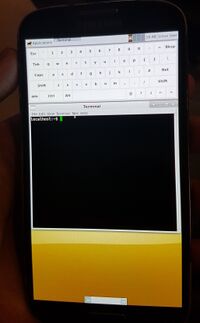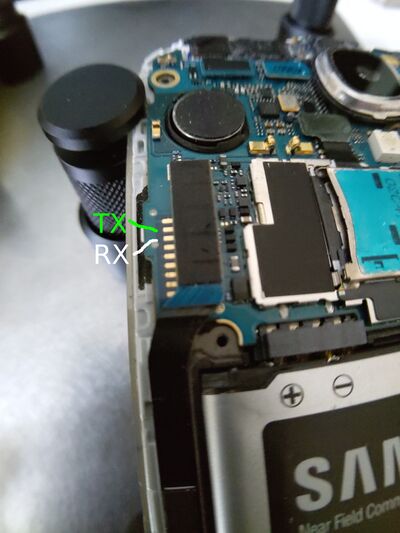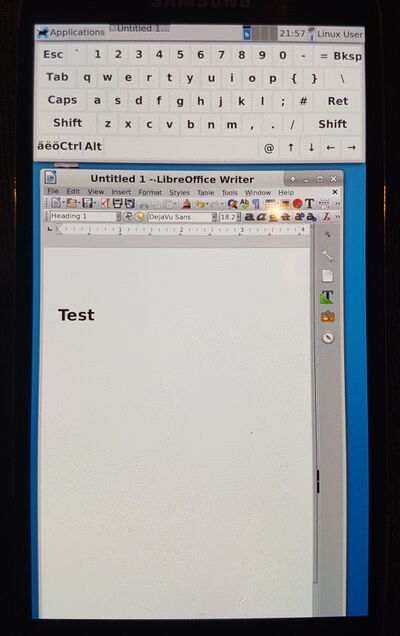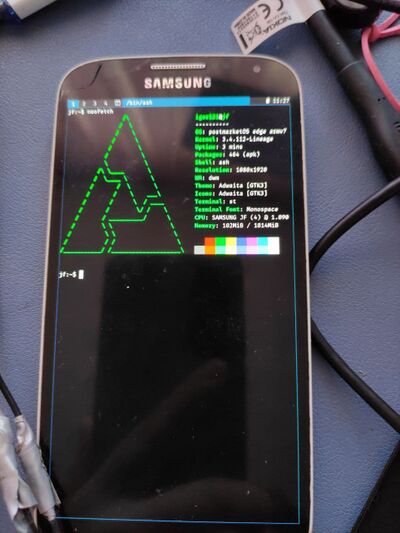Samsung Galaxy S4 (samsung-jflte)
| This device runs a Downstream kernel. Some UIs will not work, and most features (3D acceleration, audio, etc.) may be broken. |
 Galaxy S4 | |
| Manufacturer | Samsung |
|---|---|
| Name | Galaxy S4 |
| Codename | samsung-jflte |
| Released | 2013 |
| Type | handset |
| Hardware | |
| Chipset | Qualcomm Snapdragon 600 (APQ8064AB) |
| CPU | Quad-core 1.9 GHz Krait 300 |
| GPU | Adreno 320 |
| Display | 1080x1920 AMOLED |
| Storage | 16/32 GB |
| Memory | 2 GB |
| Architecture | armv7 |
| Software | |
Original software The software and version the device was shipped with. |
Android 4.2.2 |
Extended version The most recent supported version from the manufacturer. |
Android |
| postmarketOS | |
| Category | downstream |
Mainline Instead of a Linux kernel fork, it is possible to run (Close to) Mainline. |
no |
pmOS kernel The kernel version that runs on the device's port. |
3.4.113 |
Unixbench score Unixbench Whetstone/Dhrystone score. See Unixbench. |
717.1 |
| Device package |
|
| Kernel package |
|
Flashing Whether it is possible to flash the device with pmbootstrap flasher. |
Works
|
|---|---|
USB Networking After connecting the device with USB to your PC, you can connect to it via telnet (initramfs) or SSH (booted system). |
Works
|
Battery Whether charging and battery level reporting work. |
Works
|
Screen Whether the display works; ideally with sleep mode and brightness control. |
Works
|
Touchscreen |
Works
|
| Multimedia | |
3D Acceleration |
Untested
|
Audio Audio playback, microphone, headset and buttons. |
Untested
|
Camera |
Untested
|
| Connectivity | |
WiFi |
Works
|
Bluetooth |
Untested
|
GPS |
Untested
|
| Modem | |
Calls |
Untested
|
SMS |
Untested
|
Mobile data |
Untested
|
| Miscellaneous | |
FDE Full disk encryption and unlocking with unl0kr. |
Works
|
| Sensors | |
Accelerometer Handles automatic screen rotation in many interfaces. |
Untested
|
| This device is based on the Snapdragon 600. See the SoC page for common tips, guides and troubleshooting steps |
| This page is about "Galaxy S4" variants that use the Qualcomm Snapdragon 600 SoC, see #Model variants. |
Contributors
- i9505_someone (rrooij on GitHub)
- GrantM11235
Maintainer(s)
Users owning this device
- Bastindo (Notes: 2x black, one has a cracked screen)
- Beni
- BenWolsieffer
- Chmod-rwx (Notes: 3x, 2 working 1 untested)
- Chronos (Notes: with lineageos)
- Danfigasystems (Notes: unknown model. Screen broken)
- Fizzo
- GloomyJD (Notes: Works)
- GrantM11235
- Grimler
- I9505 someone
- Igor121 (Notes: playground?)
- Jacobk (Notes: 2x SPH-L720T, 1 of which runs pmOS w/ various usability bugs, and 1x SCH-I545V, which probably needs an exploit to flash))
- JuniorJPDJ (Notes: broken display)
- Lifehackerhansol
- Madeline1805 (Notes: jflteatt, running Android 5.1, dead screen)
- Madhaxbro (Notes: GT-I9505, runs crDroid Android + TWRP. Ready for testing. Boots lk2nd without porting, only display works! Classic design. Could run mainline some day.)
- Manty
- MayeulC (Notes: Two I9505, two I9506)
- Notnoelchannel
- Piero-e (Notes: international LTE / gt-i9505 / running official /e/OS android.11 based (jfltexx))
- PL (Notes: Boots pmOS, screen black. USB Networking works, normal networking is a hassle but can be made to work)
- SnappedAll (Notes: cm13, suspicious display, 2ndary phone)
- Thekingkerellos (Notes: Cant get pmos to boot so im just porting a11/12 roms to this device)
- Tuxorials (Notes: broken screen)
- Ungeskriptet (Notes: Missing battery and broken panel; Compatible with jfvelte panel)
- WeirdTreeThing
Model variants
Galaxy S4 (LTE) "JF?"
- GT-I9505 (Global) - Compatible.
- GT-I9505G (?, Smaller /system partition) - Compatible.
- SCH-I545V (US?, ?) - Locked! Compatible?
- SGH-I337M (Canada?, ?) - Compatible.
- SGH-M919 (Canada?, ?) - Compatible.
- SPH-L720T (US, Sprint, "jfltespr") - Compatible.
See #Similar devices for more details.
Firmware
Locked bootloader
Watch out, some versions have bootloaders that can't be unlocked, although the locked versions have a bootloader that contains a bug.
Boot modes
How to enter flash mode
Press volume down + the power button to enter Download Mode. It is now possible to use Heimdall for flashing.
Installation
- Install pmbootstrap
pmbootstrap init
pmbootstrap install
- Put your S4 in Download Mode (Volume Down + Power) and connect it with USB
pmbootstrap flasher flash_kernel
- After the kernel is flashed, the device will reboot. Hold the volume down button while it boots up to re-enter Download Mode
pmbootstrap flasher flash_rootfs
Battery
This device uses removable 2600 mAh Li-Ion batteries. Large aftermarket batteries (with a custom back cover) are made by third parties.
| WARNING: Be careful with degraded batteries. They may cause issues. Some UIs will not power the device off automatically on low charge! |
BMS
Unknown. Needs more research.
Charger
Unknown. Needs more research.
Fuelguage
Unknown. Needs more research.
Wireless connectivity
WiFi
Once the device has been successfully initialized, enable it:
$ sudo ip link set wlan0 up
Configure wpa_supplicant (only necessary on encrypted networks):
$ wpa_passphrase $YOUR_SSID | sudo tee /etc/wpa_supplicant/wlan0.conf <enter passphrase here and press Enter>
Connect to network using wpa_supplicant:
$ sudo wpa_supplicant -B -i wlan0 -c /etc/wpa_supplicant/wlan0.conf
If your network uses DHCP, start the DHCP client:
$ sudo udhcpc -i wlan0
Downstream kernel
What works
- Compiling the latest lineageos kernel with some patches applied
- Booting a graphical screen when installing PostmarketOS as recovery zip in TWRP.
- Network connection via USB and SSH access
- Screen works
- Brightness can be changed by echoing a value to /sys/class/backlight/panel/device/backlight as root
- Wifi with properietary blobs
- Touch screen
- Wayland
- X11
- Keyboard and mouse with USB OTG adapter (Hotplug works)
- Initramfs password entry for full disk encryption
What does not work
- Touch screen requires a reboot to work in some rare cases
- 3D acceleration
- Wayland default on screen keyboard
SPH-L720T
- SXMO works with touch.
- USB networking does not work properly.
- ping works early on in boot, but then it stops working, and SSH never works.
- Other interfaces I tried, Xfce4 and MATE, did not work.
- Wayland is untested.
- USB OTG keyboard works, other devices untested.
Mainline kernel
Currently unsupported. Has partial DTS, WIP.
Notes
Hardware / sensors detail
Output from hwtest on jfltespr sph-l720t:
hwtest output (jfltespr)
| Category | Model | Path | Status | Value |
|---|---|---|---|---|
| framebuffer | msmfb44_80901 | /sys/class/graphics/fb0 | Working | U:1080x1920p-0 |
| framebuffer | msmfb44_70001 | /sys/class/graphics/fb1 | Working | |
| framebuffer | msmfb44_a0001 | /sys/class/graphics/fb2 | Working | |
| input | sec_touchkey | /dev/input/event20 | Working | |
| input | gpio-keys | /dev/input/event19 | Working | |
| input | apq8064-tabla-snd-card Headset Jack | /dev/input/event18 | Working | |
| input | apq8064-tabla-snd-card Button Jack | /dev/input/event17 | Working | |
| input | ssp_context | /dev/input/event16 | Working | |
| input | meta_event | /dev/input/event15 | Working | |
| input | step_cnt_sensor | /dev/input/event14 | Working | |
| input | step_det_sensor | /dev/input/event13 | Working | |
| input | sig_motion_sensor | /dev/input/event12 | Working | |
| input | geomagnetic_sensor | /dev/input/event11 | Working | |
| input | temp_humidity_sensor | /dev/input/event10 | Working | |
| input | proximity_sensor | /dev/input/event9 | Working | |
| input | light_sensor | /dev/input/event8 | Working | |
| input | gesture_sensor | /dev/input/event7 | Working | |
| input | pressure_sensor | /dev/input/event6 | Working | |
| input | gyro_sensor | /dev/input/event5 | Working | |
| input | accelerometer_sensor | /dev/input/event4 | Working | |
| input | sec_touchscreen | /dev/input/event3 | Working | |
| input | max77693-muic | /dev/input/event2 | Working | |
| input | sii8240_rcp | /dev/input/event1 | Working | |
| input | pmic8xxx_pwrkey | /dev/input/event0 | Working |
For reference, sensor information from sensors sandbox (f-droid) on jfltespr sph-l720t; note that in addition to hardware-based sensors, it presumably includes software-based / derived sensors:
sensor details (sensorssandbox)
| name | vendor | version | type |
|---|---|---|---|
| K330 3-axis accelerometer | STMicroelectronics | 1 | 1 |
| YAS532 magnetic sensor | Yamaha Corp | 1 | 2 |
| K330 gyroscope sensor | STMicroelectronics | 1 | 4 |
| Barometer sensor | BOSCH | 1 | 6 |
| MAX88920 proximity sensor | MAXIM, inc. | 1 | 8 |
| CM3323 RGB sensor | Capella Microsystems, inc. | 1 | 5 |
| SHTC1 relative humidity sensor | Sensirion | 1 | 12 |
| SHTC1 ambient temperature sensor | Sensirion | 1 | 13 |
| YAS532 magnetic sensor uncalibrated | Yamaha Corp | 1 | 14 |
| Samsung significant motion sensor | Samsung, inc | 1 | 17 |
| Samsung, inc | 1 | 18 | |
| Samsung step counter sensor | Samsung, inc | 1 | 19 |
| Uncalibrated gyroscope sensor | Samsung, inc | 1 | 16 |
| Screen orientation sensor | Samsung electronics | 3 | 65558 |
| Rotation vector sensor | AOSP | 3 | 11 |
| Gravity sensor | AOSP | 3 | 9 |
| Linear acceleration sensor | AOSP | 3 | 10 |
| Orientation sensor | AOSP | 1 | 3 |
Main board UART
To simplify getting logs when doing development, it can be useful to connect to UART directly on the main board. UART (and supposedly JTAG) can be found close to the battery connector, among in 11 pads at the edge of the PCB. TX (from phone's perspective) is second pad from the top, and RX the third one. The device uses 1.8 V signal strength.

Photos
Links
Source code
- Downstream kernel (LineageOS)
Instructions
- Disassembly (Teardown)

